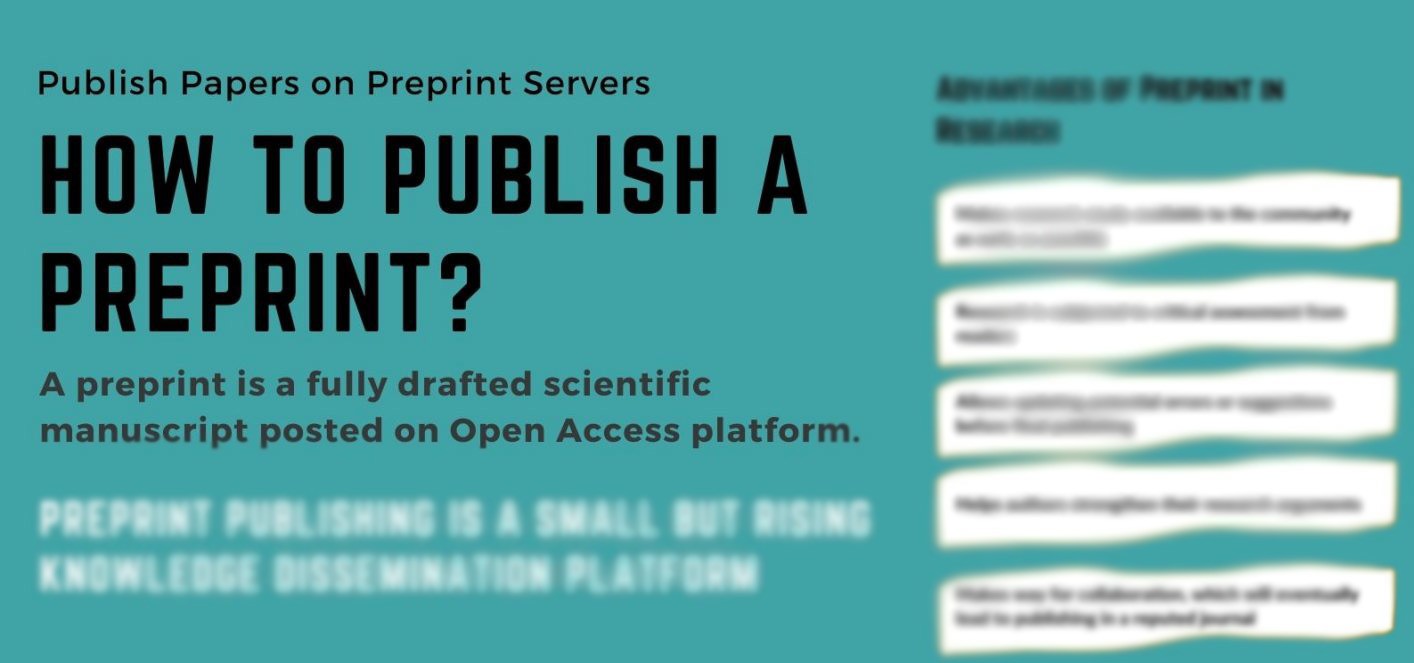What Is a Preprint? 5 Step Guide to Successfully Publish Yours!

The article is also available in: Turkish, Spanish, Portuguese, and Russian
“I think you should go ahead and publish it on a preprint platform. Your research is a crucial link for understanding fundamental research. The more we wait to publish your work in an academic journal and continue with the traditional process, the more is the risk of someone else publishing it before you. Think about it.” said your colleague, time and again. However, you had multiple questions, and nowhere to find their answers. Well, not anymore! Here we have answers to all your questions and a complete step-wise guide to publish a preprint ready article.
What Are Preprint Articles?
A Preprint is a fully drafted research paper that is available as Open Access to all, before it undergoes peer review. Authors get credit for the work published on preprint platform and get visibility and recognition for the same. Furthermore, authors are able to share their research quicker as compared to journal publishing, which is a thorough and longer process. The papers published on preprints servers are assigned with DOI and citable at discretion of the user, as the papers have not undergone the scrutiny of a peer reviewer. However, it helps valuable research reach the scholarly community much in time.
What Are the Advantages of Preprint Article in Research?
Preprint publishing is a small but rising knowledge dissemination platform in the field of research. It assists in making research studies available on various preprint journal. Preprints benefit the research in following ways:
- Makes research study available to the community as early as possible
- Readers can critically assess the research papers published on preprint platform
- Allows updating potential errors or suggestions before final publishing
- Helps authors strengthen their research arguments
- Makes way for collaboration, which will eventually lead to publishing in a reputed journal.
Publish Papers on Preprint Servers
Scholarly papers that are not yet accepted by academic journals, are posted on Preprint servers. Preprint servers are online repositories that contain data and information of various scholarly papers. The papers sent to these repositories undergo basic screening and plagiarism check; however, are not peer reviewed. Various preprint servers are –
1. BioRxiv
It is an open access preprint repository for biological sciences and hosted by the Cold Spring Harbor Laboratory.
2. arXiv
It is a multidisciplinary preprint repository for physics, mathematics, computer science, quantitative biology, statistics, electrical engineering, and system sciences.
3. ChemRxiv
It is an open access preprint repository for chemical science. The American Chemical Society, Royal Society of Chemistry and German Chemical Society operates this repository.
4. The Winnower
It is an open access online scholarly publishing platform. It allows researchers and colleagues to undergo scholastic discussions of topic review the posted scholarly
5. PrePubMed
It indexes preprint articles from PeerJ preprints, BioRxiv.

To Download the Infographic, Click Here!
5 Steps to Produce a Preprint Article
1. Know Your Target Audience, Know Your Paper
Preprints publish articles from various fields of research that deliver original scientific work. The papers can be of different types like, Original Paper/Article, Review Paper/Article, Case Report, Conference Report, Technical Notes, Hypothesis, etc. Paper submitted for preprint publishing should not be under journal or conference proceedings, as the aim of preprints is to create a platform for original research. It is important to know who is the target audience for the preprint paper you are planning to publish. This allows you to set the tone of the paper and will help you choose the correct repository as well.
2. Write an Impactful Title and Abstract
The “Title” and “Abstract” are first to gauge most attention by your audience. Therefore, it is important to write an effective title and abstract for your paper. Avoid unnecessary jargons and mention the keywords in the title. Keep it concise and informative; it is a concentrated version of the manuscript. Therefore, make sure to keep the abstract detailed and include all aspects of the research. It is essential to keep the abstract unbiased, i.e. you should mention favorable outcomes and results, but also mention any non-significant and adverse data. This gives the author an authoritative right on the research work and help get through the screening process effortlessly.
3. Adhere to Publishing Ethics
Although not peer reviewed, it is a scientific paper that needs accuracy in stating the research findings. Authors must follow the COPE Guidelines and include an objective discussion over the significance of research. Any kind of plagiarism, data fabrication, and image modification (knowingly or unknowingly) is not permitted and the paper will be rejected in the screening process of preprint publishing. Ensure to take copyright permissions for the data used to support the research objectives and declare conflict of interests while submitting the paper for preprint publishing.
4. Authors Must Qualify Authorship and Link Their ORCID
All the authors who contribute to the paper must be aware and agree to the submission to preprint journal. Authors should qualify for authorship as per the authorship guidelines. Furthermore, authors should get themselves registered in ORCID and link their ORCID to the preprint repository during the submission process. This increases the authenticity of the published preprint paper and can acquire more recognition and citation.
5. Finally, Be Aware of the Details Related to Manuscript Withdrawal
Preprint research papers cannot be withdrawn once published! Although this is true, there are situations in which the paper can be retracted from the preprint server. Preprint papers can be retracted in the following situations –
- Data fabrication and plagiarism
- Scientific errors that cannot be corrected by updating the manuscript
- Copyright violation
At the discretion of the preprint server editors and advisory committee, the paper will be deleted from the repository.
How to Publish a Research Paper on a Preprint Platform?
Based on the type of research paper, a researcher can choose the repository to publish his/her paper.
Steps to Publish on a Preprint Server:
- Create an account and register on the preprint server site.
- Submit the abstract, as per the guidelines iterated by the preprint.
- Before the paper is posted online, the manuscript will undergo a short screening process. Screening mainly includes checking basic scientific content, author background, and compliance to ethical aspects.
- Post publishing, the paper will be available on the repository for others to download, share, comment on, and cite.
Conclusion
In conclusion, preprint publishing is becoming popular but there are pros and cons to this process and authors are advised to choose wisely before deciding what to do with their years of hard work of generating the research data.
Do let us know if you have published an article on a preprint server. How was the process? Were you able to go through the process easily? Do comment below or write to us and tell us about your first ever preprint experience.










Toᥙche. Great arguments. Keep up the good effort.
good information!